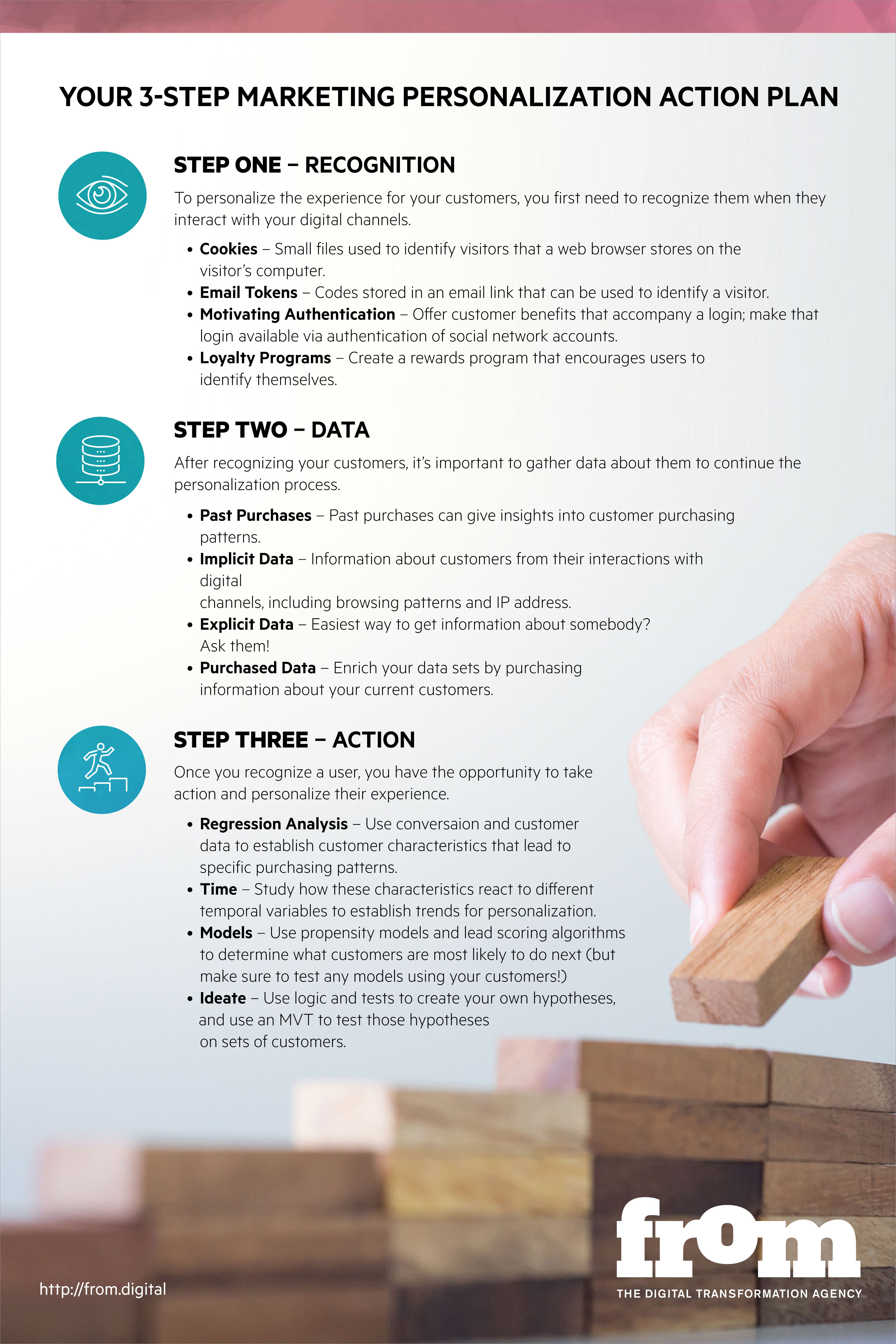
Your Three Step Personalization Action Plan
Marketing Personalization is the process of taking customized action based on what you know about a specific individual.
If you know it’s their birthday, you might wish them a happy birthday. If you know they have a new family member, you show how your product is great for young children. If you know they care about luxury, you show them your top-of-the-line product. In our last article, we talked about the benefits of this kind of personalization.
But how do you execute it? Personalization requires three basic steps:
1. Recognition
In order to personalize an experience, we must first know who it is we’re talking to. In the realm of traditional direct mail, this is straightforward, since we’ve already addressed the communication. In the digital realm, however, it can be more difficult to know who we’re dealing with specifically. Similarly, in the “real world,” our representatives speak with unidentified prospects and customers. There are a variety of ways to try to increase the likelihood that we recognize these customers.
Key Tactics:
- COOKIES: In web and mobile, set cookies anytime a user creates an account so that when they return to the site, they can be recognized. Cookies are small files that a web browser can store on the visitor's computer to uniquely identify them.
- EMAIL TOKENS: Links in email communications should contain codes (tokens) that pass the unique identity of the user to the web server. The moment the web server receives the token to recognize the user, it should then also set a cookie, so that future visits to the site from bookmarks, search or other means continue to result in recognition.
- MOTIVATING AUTHENTICATION: Create benefits within our digital experience that are available only once the user is logged in. Combine this with easy account setup, or the ability to authenticate with social accounts such as Facebook or Google+, so that the level of effort required for a user to authenticate is very low. And again, once a user authenticates, cookie them immediately so that you can identify them in the future, whether they authenticate or not.
- LOYALTY PROGRAMS: In the real world, the use of loyalty programs is a common tactic to encourage customers to identify themselves, at least at checkout. However, new methods are emerging. At Disney theme parks, all guests now wear wristbands with RFID chips that let Disney know where that guest is and let Disney characters, or cast members, interact with them in personalized ways based on their profile. In the future, our wearable devices or mobile phones will interact similarly. Some leading retailers, for example, are already delivering alerts to store personnel when high-value customers (based on their profile) enter the store.
2. Data
In order to personalize, we must know something about the user that we’ve recognized. This may be their preferences, demographic information, purchase timeframe, or other data. Where do we get this data? In general, think of this in terms of two different scenarios: customers and prospects. In the case of customers, you probably have a wealth of data. For new prospects, you may have to work harder to quickly establish a data set for personalization.
Key Tactics:
- PAST PURCHASES: Past purchases are a powerful source of data. Be sure your real-time marketing systems have access to this data — at least in an aggregated form — so that you have the ability to use it for personalization. Sophisticated marketers are increasingly combining cross-channel purchase histories to get a complete picture of a customer’s patterns.
- IMPLICIT DATA: There’s much that can be quickly inferred as users begin to interact with you, even if they’re anonymous. From the first moment a user visits your site, you receive their IP address, which can usually be used to determine approximate geographic location. And, if they’re surfing from their company offices, the IP address can be used to determine the name of the company whose network they’re on. Browsing patterns on your site can also be used for segmentation. For example, a hotel chain may “tag” pages of their web site to segment prospects. A user who visits pages about a kids’ program at a resort may be tagged as likely having children, versus another customer who browses pages about the nightclub. This kind of “soft targeting” can then influence which types of follow-up emails the user receives, or what promotion appears on the home page the next time they visit the site.
- EXPLICIT DATA: You can always ask both prospects and customers to tell you about themselves, and store that information for future personalization. People tend to not enjoy filling out a lot of fields, so it’s important to be selective about what you ask and to communicate the value proposition for providing the information. For some sites we’ve worked on, we’ve come up with creative ideas for site capabilities that logically require the user to provide information (e.g., a resort web site that provides information about special discounts and programs if you provide your intended date of travel).
- PURCHASED DATA: When targeting known individuals in advance (such as through email or direct mail), or for your current customers, you can enrich your data set by purchasing additional fields from a variety of sources. Common things to look for include level of affluence, home ownership, psychographic segment, and age.
3. Action
Once we’ve recognized a user about whom we have some data, we have the opportunity to take action and personalize the experience. How do you know what to personalize? In our last article, we covered the three key reasons to personalize an experience: 1) to make the customer feel special, 2) to present the right offer at the right time and 3) to create a better customer experience, usually through increased convenience. In terms of making the customer feel special, simply referring to a past interaction can create a moment of surprise and appreciation. Creating a better experience is often about providing saved information, or “smart” defaults, based on past behavior. Saving particular information, such as the user’s address; suggesting that someone renting a car might want the same car and options they elected on their last rental, thereby saving them from making those choices again; or allowing customers to do “one-click” re-ordering rather than searching again for the same consumable product they previously purchased, are all great examples of ways to easily create a better, more personalized digital experience. Putting the right offer in front of the right customer at the right time? That’s usually the trickiest of the three. Here are a few suggestions:
Key Tactics:
- REGRESSION ANALYSIS: Use your website conversion data in combination with your customer data to look for patterns to help establish what types of customer characteristics lead to which types of purchases. This can start to establish patterns within your customer base that show the most promising offers to put in front of specific customers.
- TIME: Time of day, time of week and seasonality can also have a major impact on “the right offer at the right time,” so also study how customers with specific data characteristics respond based on these temporal variables. Your digital marketing tools should enable you to adjust the personalization logic based on time -- weekday vs. weekend -- or similar factors.
- MODELS: In certain industries, such as Financial Services, sophisticated propensity models can be purchased to help identify the customer’s “next most likely product to purchase.” These and other “lead scoring” algorithms can help identify the most promising products or services to promote. However, any generalized model should be tested over time with your customers, to make sure it’s performing as expected.
- IDEATE: Lastly, use your own logic and intuition to develop hypotheses, and TEST those hypotheses. Use an MVT (multivariable testing) tool to allow you to create a personalization rule that will be randomly applied to only a small percentage of your site users, perhaps 5%, and then study the statistical results once you have a reasonably-sized data set. Leverage those within your organization who best know your customers to generate these hypotheses. Many of the hypotheses will be wrong, so make your testing process fairly low-investment. When you find a new insight that does hit, it can be very valuable.
